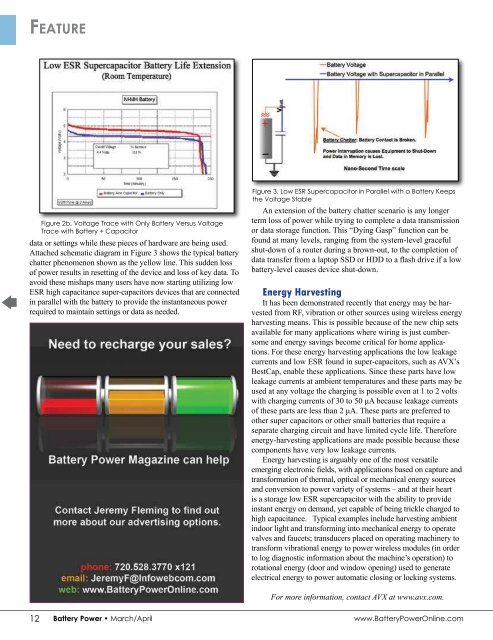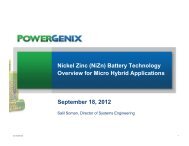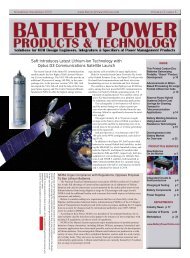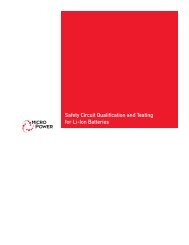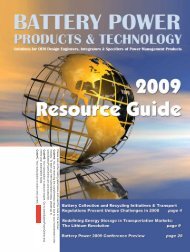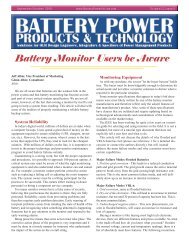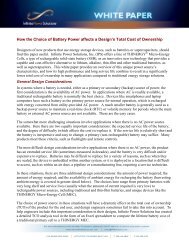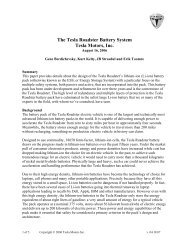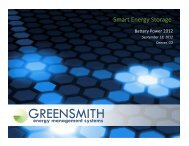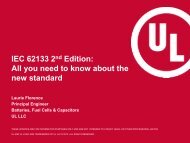Battery Management Systems - Battery Power Magazine
Battery Management Systems - Battery Power Magazine
Battery Management Systems - Battery Power Magazine
Create successful ePaper yourself
Turn your PDF publications into a flip-book with our unique Google optimized e-Paper software.
Feature<br />
Figure 2b. Voltage Trace with Only <strong>Battery</strong> Versus Voltage<br />
Trace with <strong>Battery</strong> + Capacitor<br />
data or settings while these pieces of hardware are being used.<br />
Attached schematic diagram in Figure 3 shows the typical battery<br />
chatter phenomenon shown as the yellow line. This sudden loss<br />
of power results in resetting of the device and loss of key data. To<br />
avoid these mishaps many users have now starting utilizing low<br />
ESR high capacitance super-capacitors devices that are connected<br />
in parallel with the battery to provide the instantaneous power<br />
required to maintain settings or data as needed.<br />
Figure 3. Low ESR Supercapacitor in Parallel with a <strong>Battery</strong> Keeps<br />
the Voltage Stable<br />
An extension of the battery chatter scenario is any longer<br />
term loss of power while trying to complete a data transmission<br />
or data storage function. This “Dying Gasp” function can be<br />
found at many levels, ranging from the system-level graceful<br />
shut-down of a router during a brown-out, to the completion of<br />
data transfer from a laptop SSD or HDD to a flash drive if a low<br />
battery-level causes device shut-down.<br />
Energy Harvesting<br />
It has been demonstrated recently that energy may be harvested<br />
from RF, vibration or other sources using wireless energy<br />
harvesting means. This is possible because of the new chip sets<br />
available for many applications where wiring is just cumbersome<br />
and energy savings become critical for home applications.<br />
For these energy harvesting applications the low leakage<br />
currents and low ESR found in super-capacitors, such as AVX’s<br />
BestCap, enable these applications. Since these parts have low<br />
leakage currents at ambient temperatures and these parts may be<br />
used at any voltage the charging is possible even at 1 to 2 volts<br />
with charging currents of 30 to 50 μA because leakage currents<br />
of these parts are less than 2 μA. These parts are preferred to<br />
other super capacitors or other small batteries that require a<br />
separate charging circuit and have limited cycle life. Therefore<br />
energy-harvesting applications are made possible because these<br />
components have very low leakage currents.<br />
Energy harvesting is arguably one of the most versatile<br />
emerging electronic fields, with applications based on capture and<br />
transformation of thermal, optical or mechanical energy sources<br />
and conversion to power variety of systems – and at their heart<br />
is a storage low ESR supercapacitor with the ability to provide<br />
instant energy on demand, yet capable of being trickle charged to<br />
high capacitance. Typical examples include harvesting ambient<br />
indoor light and transforming into mechanical energy to operate<br />
valves and faucets; transducers placed on operating machinery to<br />
transform vibrational energy to power wireless modules (in order<br />
to log diagnostic information about the machine’s operation) to<br />
rotational energy (door and window opening) used to generate<br />
electrical energy to power automatic closing or locking systems.<br />
For more information, contact AVX at www.avx.com.<br />
12 <strong>Battery</strong> <strong>Power</strong> • March/April<br />
www.<strong>Battery</strong><strong>Power</strong>Online.com


